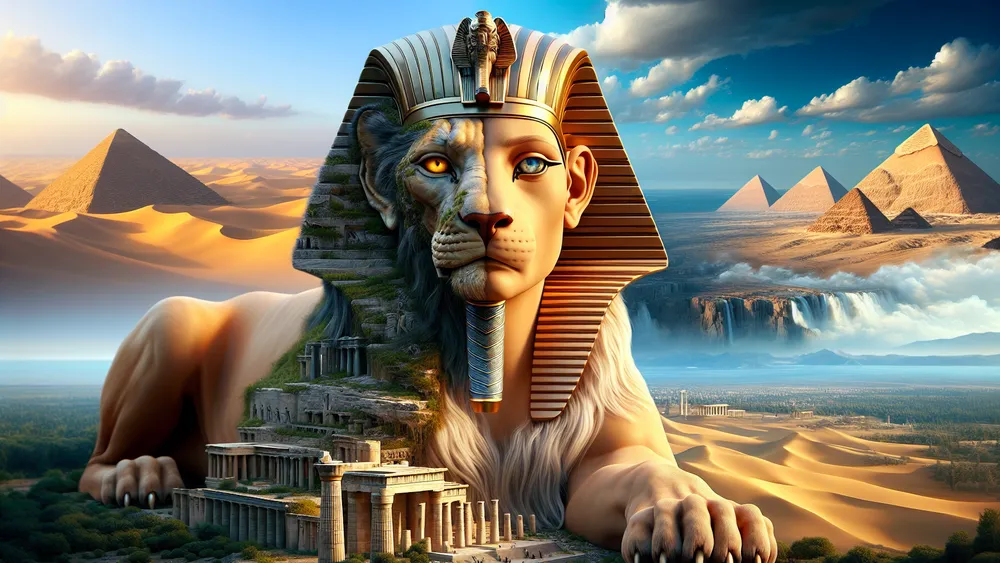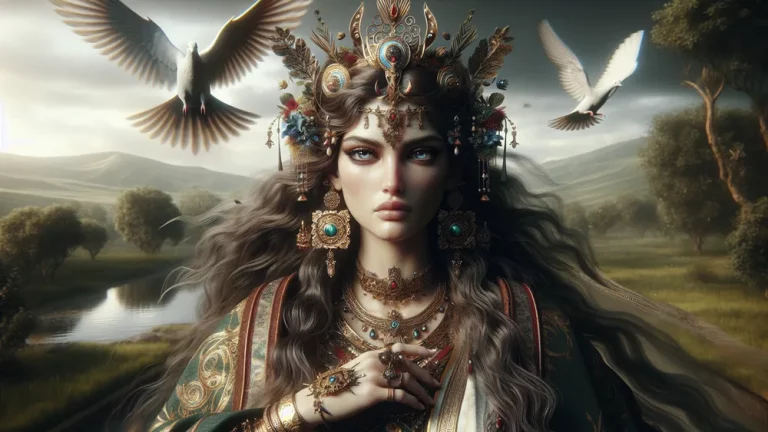Sphinx: Mythical Creature Of Egypt And Greece
Greetings. Here, you are about to read about a really interesting creature that exists in both Egyptian and Greek stories: the Sphinx. Picture something with a lion’s body and a human’s head; a symbol that people have thought about for thousands of years. This blog will look at where the Sphinx comes from, what it looks like, and what it means to different cultures.
Key Points:
- The Sphinx is a mythical creature with a lion’s body and a human head, found in Egyptian and Greek stories.
- The Egyptian Sphinx symbolizes royal strength and safety, while the Greek Sphinx poses riddles and challenges heroes.
- The word Sphinx comes from a Greek term meaning to bind or to squeeze.
- The Great Sphinx of Giza, built around 2500 BCE, symbolizes royal power and guarding in Egypt.
- The Sphinx in Greek tales, like in the story of Odeipus, represents mystery, mental challenges, and fate.
- Sphinxes appear in the art and stories of other cultures like the Minoan, Mycenaean, Assyrian, and Persian civilizations.
- The Sphinx remains a popular symbol in modern media, appearing in books, movies, logos, and artwork.
You will find out how the Egyptian Sphinx, which is linked to big buildings like the Great Sphinx of Giza, is different from the Greek Sphinx, which is known from the story of Oedipus. As we go through times, art pieces, and books, you will see how people from different times and places have thought about this puzzler.
No matter if you are new to stories about gods and creatures or if you know a lot about them, this guide will give you a better idea of what the Sphinx means and why it is still talked about.
Sphinx: Overview and Key Facts
| Key Point | Description |
|---|---|
| Definition | A creature from myths, with a lion’s body and a human’s head. |
| Origins | Seen in stories from Egypt and Greece. |
| Egyptian Sphinx | Shown as a man with a ruler’s hat, meaning strength and safety. |
| Greek Sphinx | Shown as a woman, who asks tricky questions, linked to the story of Oedipus. |
| Cultural Importance | Means different things in Egypt and Greece; in Egypt, it’s a protector, in Greece, it’s a puzzler. |
| Looks | Has parts of a lion (power) and a human (smartness). |
| Meaning | In Egypt, it means kingly power and safety; in Greece, it means puzzles and secrets. |
| Known Examples | The big Sphinx in Egypt; the Sphinx from Oedipus’ story in Greece. |
| Origin of the Word | The word “Sphinx” comes from a Greek word “sphingein,” which means “to bind” or “to squeeze.” |
| History | Goes back to old times, with important finds in Egypt and Greece. |
| In Art and Texts | Found in statues, paintings, and books in many places. |
| Today | Seen in books, movies, and as a sign in modern buildings and art. |
| Care and Fixing | Continuous work to keep it in good shape, especially the Great Sphinx of Giza. |
| Myth Stories | In Egypt, guards holy places; in Greece, challenges heroes with questions. |
This table shows key points about the Sphinx, laying the groundwork for more detailed look into its role in Egyptian and Greek stories.
Getting to Know the Sphinx
To really understand the strange attraction of the Sphinx, it’s important to look into where it comes from, what it looks like, and the different parts it played in Egyptian and Greek stories. First, we need to know what a Sphinx is and how people in different places have seen it.
What Exactly is a Sphinx?
A Sphinx is a creature from myths, made from parts of a lion and a human, usually shown with a lion’s body and a human’s head. Coming from old Egyptian and Greek tales, the Sphinx has held people’s interest for many years. In short, the Sphinx stands for strength, wisdom, and mystery.
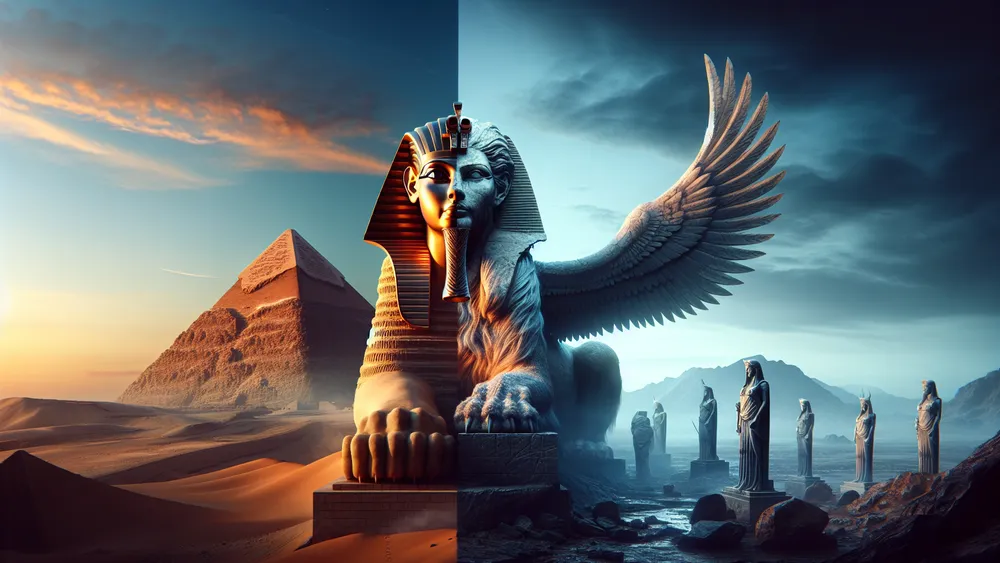
In Egyptian stories, the Sphinx is often shown as a man, often wearing a pharaoh’s headpiece, which means royal strength and safety. The most known one is the Great Sphinx of Giza, which guards the pyramids.
But, the Sphinx in Greek tales is usually a woman, known for her part in the story of Oedipus, where she asks a riddle to travelers and eats those who do not answer correctly. This difference in how they are shown highlights how important the Sphinx is to both Egyptian and Greek cultures.
To more clearly see what makes the Egyptian and Greek Sphinx different, it’s good to look at how they appear and what they stand for. The Egyptian Sphinx is known for its large size and calm look, showing it as a protector god. It often acts as a guardian of holy places like temples and tombs. Meanwhile, the Greek Sphinx is smaller and looks scarier, often shown with wings and a more threatening pose.
The Egyptian Sphinx stands for steadiness, order, and godly kingship, while the Greek Sphinx stands for puzzles, danger, and the test of facing challenges. In Greek myths, the Sphinx’s job is to check the hero’s mind and bravery, like in the story of Oedipus. Here is a simple list to show these differences:
Egyptian Sphinx:
- Male figure with a pharaoh’s headpiece
- Stands for royal strength and safety
- Guard of holy places
Greek Sphinx:
- Female figure with wings
- Stands for mystery and danger
- Tests heroes with riddles
By looking at these differences, we can see the special parts the Sphinx played in their own myths and the big effect they have had on culture over time.
Where Did the Term Sphinx Come From?
The word “Sphinx” comes from the Greek word “sphingein,” which means “to bind” or “to squeeze.” This makes sense because, in Greek stories, the Sphinx asks puzzles that “bind” those who can’t solve them. The Greek Sphinx is often shown as a female figure with the body of a lion, the wings of a bird, and the head of a woman.
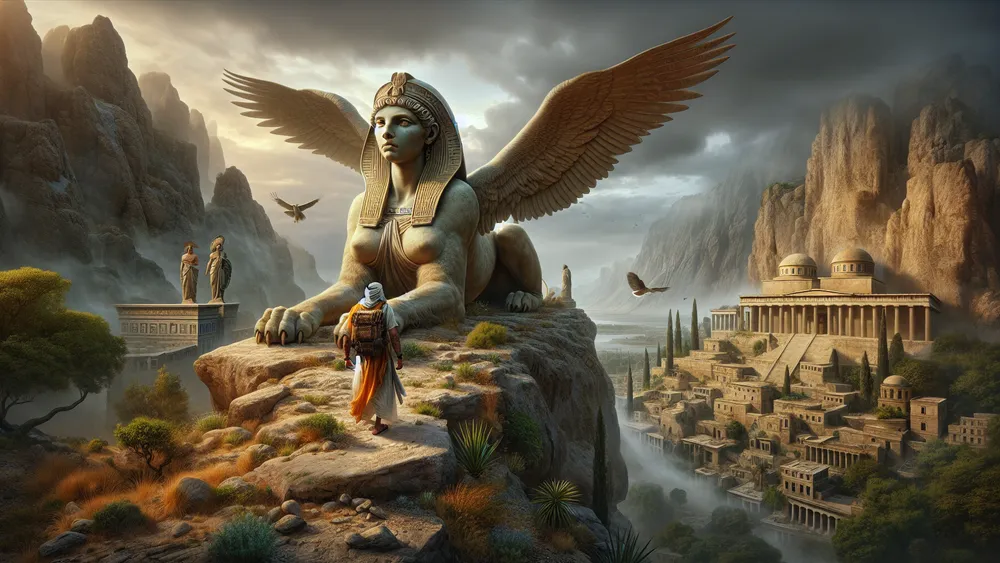
It shows both physical and mental challenges. While the word itself is Greek, there are no direct links to the Egyptian language. Yet, the idea of a lion-bodied protector with a human head is deep in Egyptian culture; they call it “shesep-ankh,” meaning “living image.” This shows how myth ideas moved and changed between places.
To see why the Sphinx matters in history, we need to look at important dates and events in both Egyptian and Greek cultures. The Great Sphinx of Giza, one of the most well-known ones, was built around 2500 BCE when Pharaoh Khafre ruled. It has been studied and repaired many times.
In Greek stories, the Sphinx shows up in the tale of Oedipus, from around the 5th century BCE. Important finds, like digging up Sphinx statues in ancient Greek places, have given us more information about its role. Here is a table that shows these key events:
| Date | Event/Discovery | Significance |
|---|---|---|
| 2500 BCE | Building of the Great Sphinx of Giza | Symbol of royal strength and safety in Egypt |
| 5th Century BCE | Appears in the story of Oedipus | Symbol of mystery and mental challenge in Greece |
| 19th Century | Studies of the Great Sphinx of Giza | Better understanding of how it was built and used |
| 20th Century | Finds of Sphinx statues in Greek places | Gave more insight into its role in Greek myths |
By looking at where the word “Sphinx” comes from and its history, we see more clearly why it has been important in both Egyptian and Greek cultures for so long.
The Egyptian Sphinx
After looking at where the Sphinx idea and word come from, now focus on the special features and importance of the Egyptian Sphinx. Let’s start with the most well-known one, the Great Sphinx of Giza.
It is very famous and known by many. The features of this Sphinx and its role in history are worth noting, as they provide a clear understanding of its symbolic meaning in ancient Egyptian culture.
The Famous Sphinx of Giza
The Great Sphinx of Giza is among the world’s well-known monuments, noted for its huge size and puzzlish look. Cut from a single limestone hill, the Sphinx spans about 73 meters (240 feet) long and stands 20 meters (66 feet) high, ranking it as one of the largest carved statues.
Its body looks like a lion, meaning power and force, while its human head, with a royal headpiece, stands for wisdom and leadership. Placed on the Giza area, the Sphinx lines up with the pyramids, mainly the Pyramid of Khafre, hinting at a planned link between these big structures. Ideas about who built the Great Sphinx and why have intrigued scholars for many years.
The most common belief says it was made during Pharaoh Khafre’s rule in the Fourth Dynasty around 2500 BCE. This idea states the Sphinx was made to guard Khafre’s pyramid area, showing the pharaoh’s god-like power and safety. But, other thoughts suggest different builders and reasons. Some think the Sphinx is from before Khafre and was made by an earlier group, while others believe it shows the sun god Ra-Horakhty.
What the Sphinx Meant in Egyptian Mythology
These debates keep sparking talks among historians and archaeologists, adding to the Sphinx’s long-lasting riddle. In Egyptian beliefs, the Great Sphinx has strong religious and story-based meanings. It is often tied to the sun god Ra and the idea of godly kingship, showing the pharaoh’s role as both a human ruler and a godly protector.
The Sphinx’s large presence at the pyramid area entrance acts as a strong sign of royal power and guarding, keeping evil away and protecting the holy burial spots. In myths, the Sphinx is linked to Ma’at, the old Egyptian idea of truth, balance, and world order.
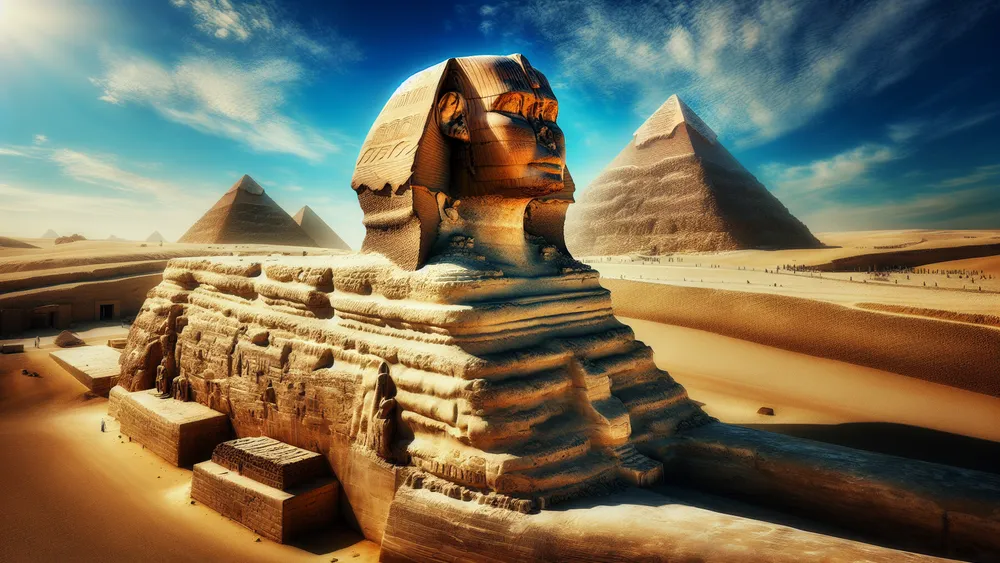
By showing these beliefs, the Great Sphinx of Giza keeps being a strong symbol of ancient Egyptian culture and its lasting impact.
Fixing Up the Sphinx Over Time
Fixing the Great Sphinx of Giza has a long and mixed history. The earliest known tries to fix it date back to about 1400 BCE, in the time of Pharaoh Thutmose IV. There is an old writing called the Dream Stele, where it says Thutmose IV tried hard to remove the sand that had covered the Sphinx up to its neck.
Over many years, different pharaohs and leaders have tried to keep and fix the Sphinx. Each one has dealt with new problems due to the rough desert setting. These days, fixing methods are more advanced, using new materials and ways to keep the Sphinx standing and stop more damage.
But, these efforts face tough problems, like bad weather, pollution, and many visitors. Keeping the Great Sphinx in good shape is very important for both history and culture. As a very well-known symbol of old Egyptian times, the Sphinx gives us valuable clues about the art, religion, and building skills back then. Its upkeep helps us keep a real link to shared human history.
Ongoing efforts to care for the Sphinx involve regular check-ups, looks at its structure, and new ways to protect it. Future plans aim to balance the need to keep the Sphinx in good shape with the needs of visitors, making sure this old monument can be enjoyed by future people.
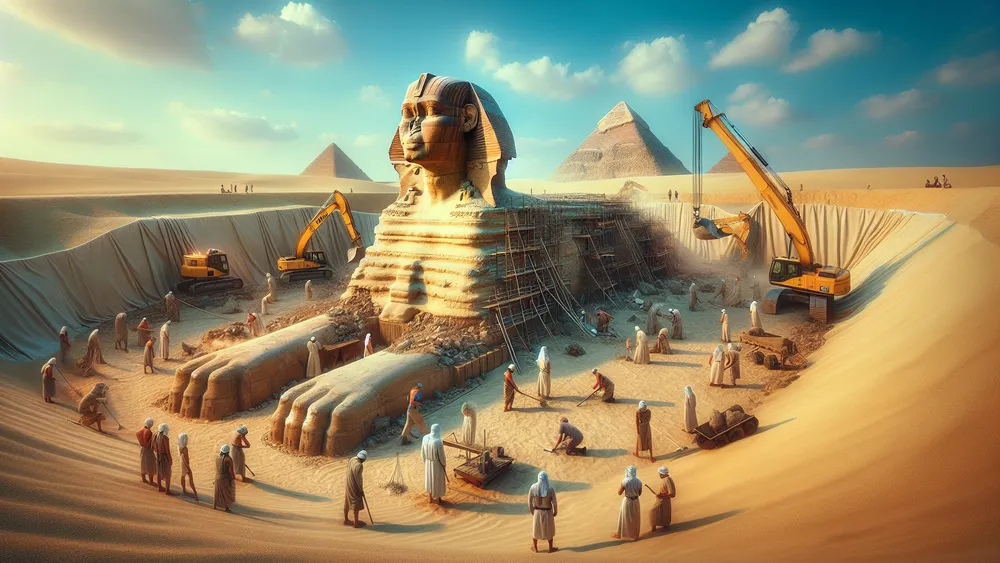
By taking care of the Sphinx, we respect the past and make sure it keeps inspiring and teaching people all over the world.
The Greek Sphinx
After looking at the long past and meaning of the Egyptian Sphinx, it is time to look at the Greek idea of this puzzlish creature, starting with its well-known myth story. The Greek version has its own place in myth and mystery, differing from what we see in Egypt.
The Story of Oedipus and the Sphinx
The story of Oedipus and the Sphinx is very well-known in Greek tales. The city of Thebes had trouble because of a huge creature called the Sphinx. It had a lion’s body, eagle wings, and a woman’s head. The Sphinx caused fear by eating those who didn’t answer her riddle. Oedipus, a young prince, got to Thebes and met the Sphinx.
Wanting to save the city, he decided to solve the riddle. The Sphinx asked, “What moves on four legs in the morning, two legs at noon, and three legs in the evening?” Oedipus answered, “Man,” which meant people crawl as babies, walk on two legs as adults, and use a cane when old. The Sphinx, beaten, jumped off a cliff, and Oedipus was seen as a hero.
The riddle of the Sphinx serves not only as a test but also shows the steps of human life. Oedipus, by solving it, showed his smart thinking and insight, which Greeks valued. The answer, “Man,” reflects the Greek interest in human nature and time. The Sphinx’s role is key, being an obstacle Oedipus needed to beat to reach his fate.
This event hints at the sad events to come in Oedipus’s life, making the Sphinx a sign of fate and unavoidable prophecy in Greek tales. The Sphinx appeared often in Greek art and stories. Artists showed her in sculptures and vase paintings, and writers wrote about her.
In Greek art, she often had a calm but mysterious look, showing her dual nature as both protector and threat. An example is the Sphinx of Naxos, a large statue that stood in Apollo’s sanctuary at Delphi. In stories, she appears in works like Sophocles’ “Oedipus Rex,” where her meeting with Oedipus is a major part.
Greeks saw the Sphinx as a sign of mystery, wisdom, and big challenges to face for greatness. Through these images and stories, the Sphinx keeps drawing interest, showing the lasting pull of Greek myths.
The Sphinx Around the World
We have looked at how Greeks saw the Sphinx. Now, let’s see how different cultures around the world describe and understand this mythical creature. Many places have their own ideas about the Sphinx, showing a wide range of meanings and roles for this figure.
Sphinxes in Different Cultures
Other than in Egyptian and Greek stories, the Sphinx also shows up in the art and tales of many older cultures. These include the Minoan, Mycenaean, Assyrian, and Persian peoples. On Minoan and Mycenaean items, Sphinxes appear often in wall paintings and other art forms. They stand for watching over and offering protection. A specific example is the Mycenaean Sphinx, found as a clay figure in the city of Mycenae.
This shows how cultures in the Aegean and Near East traded ideas. In Assyrian art, you find Sphinx-like beings, often shown as powerful gods with parts from bulls or lions and human heads, called Lamassu. These figures stand at palace and temple entrances to keep bad spirits away.
Sphinxes in Assyrian and Persian Worlds
Persian art also shows Sphinxes as winged lions or bulls, being signs of kingly power and godly protection – the mix of these cultures got displayed in later Sphinx art. What Sphinxes stand for changes in different places, showing their special ideas and purposes. In both Minoan and Mycenaean worlds, they often mean guarding and keeping safe, like in Egyptian tales.
But in Assyrian and Persian lands, they have more meanings. For example, the Assyrian Lamassu shows human smarts, animal power, and godly watching, being the perfect qualities of a protecting god. Persian Sphinxes often tie to kingly power and god’s favor, showing the focus on kings and the right to rule from the gods.
Unlike the Greek Sphinx, which is mostly a puzzle-solver and sign of mystery and fate, these meanings differ. By looking at these different Sphinx pictures, we see how this symbol changes to fit the beliefs and values of each group, still showing power and protection in some way.
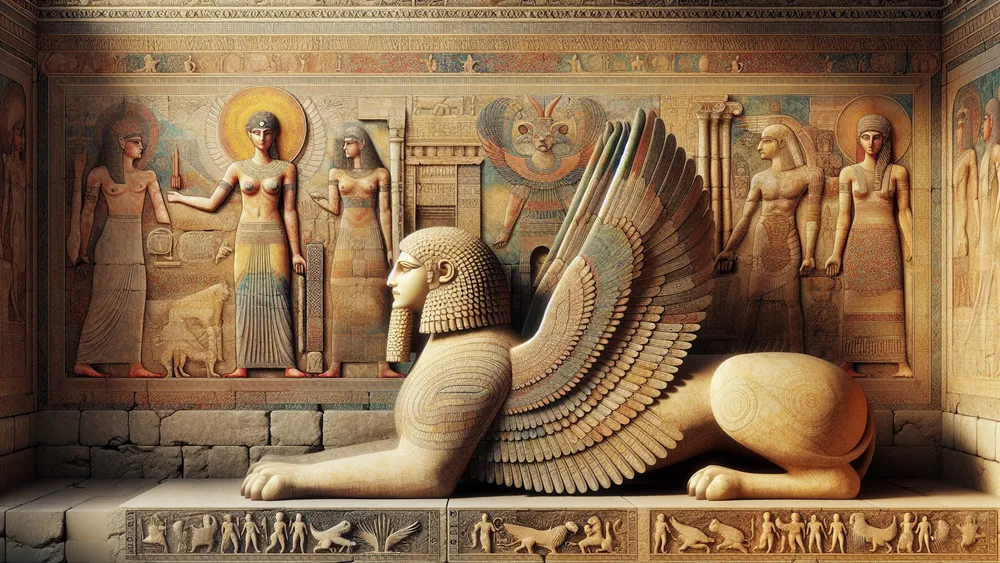
The Sphinx Today
We have looked at how different cultures showed the Sphinx in the past. Now, let’s see how this mythical being still has an effect on books, movies, and art today. The Sphinx, from ancient stories, appears in many modern works, continuing to fascinate and inspire people in varied ways. Its presence can be seen in books, films, and various artistic expressions that draw from its rich historical legacy.
The Sphinx in Books and Movies
In modern books, the Sphinx shows up a lot and catches readers’ attention with its mysterious presence. One example is in J.K. Rowling’s “Harry Potter and the Goblet of Fire,” a Sphinx asks Harry a riddle during the Triwizard Tournament, recalling an old Greek tale. Another is in Neil Gaiman’s “American Gods,” where the Sphinx is mysterious and powerful, showing its usual role as a keeper of secrets.
These depictions honor the Sphinx’s myth origins but also help new readers know about it, keeping it important in today’s culture. In books, the Sphinx often stands for knowledge, mystery, and hard challenges, fitting with themes understood by many. In movies and TV shows, the Sphinx stays interesting, often shown reflecting current ideas and values.
For example, in the 1994 film “Stargate,” the Sphinx is linked to aliens, mixing old myths with science fiction to look at human history’s puzzles. In “Gargoyles,” an animated series, the Sphinx is wise and very old, standing for always knowing and protecting. These show how the Sphinx can fit different stories and settings.
By looking at these modern depictions, we see how the Sphinx still inspires and interests, acting as a link between old myths and new ideas.
Books with the Sphinx:
- “Harry Potter and the Goblet of Fire” by J.K. Rowling
- “American Gods” by Neil Gaiman
- “The Sphinx” by Edgar Allan Poe
These books show how people still love the Sphinx, and it can hold audience interest across different forms and cultures.
List of All Egyptian Mythology Creatures
Egyptian mythology is rich with a wide array of mythical creatures, each with its unique attributes and symbolic meanings.
Among the most notable are the Sphinx, a guardian figure with the body of a lion and the head of a human, symbolizing royal power and protection; the Bennu, a heron-like bird associated with the sun, creation, and rebirth, often linked to the phoenix; and the Apophis (Apep), a giant serpent representing chaos and evil, eternally battling the sun god Ra.
For a comprehensive exploration of fascinating beings from ancient Egyptian lore, check out this list of all Egyptian mythology creatures.
FAQs
1. What is the significance of the Sphinx in Egyptian mythology?
The significance of the Sphinx in Egyptian mythology lies in its representation of royal power, protection, and the divine authority of the pharaohs.
2. How did the Greeks interpret the Sphinx differently from the Egyptians?
The Greeks interpreted the Sphinx differently from the Egyptians by portraying it as a malevolent creature that posed riddles and brought destruction, whereas the Egyptians saw it as a protective and benevolent guardian.
3. Are there any other cultures that have similar mythical creatures to the Sphinx?
Other cultures that have similar mythical creatures to the Sphinx include the Minoan, Mycenaean, Assyrian, and Persian civilizations.
4. What are some of the most famous depictions of the Sphinx in modern media?
Some of the most famous depictions of the Sphinx in modern media include its appearances in movies like “The Mummy” and books such as “Harry Potter and the Goblet of Fire.”

